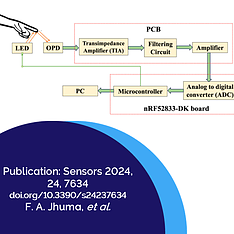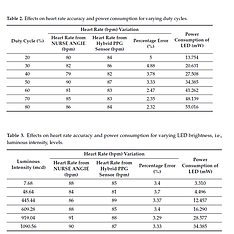A Hybrid Photoplethysmography (PPG) Sensor System Design for Heart Rate Monitoring
A photoplethysmography (PPG) sensor is a cost-effective and efficacious way of measuring health conditions such as heart rate, oxygen saturation, and respiration rate. In this work, we present a hybrid PPG sensor system working in a reflective mode with an optoelectronic module, i.e., the combination of an inorganic light-emitting diode (LED) and a circular-shaped organic photodetector (OPD) surrounding the LED for efficient light harvest followed by the proper driving circuit for accurate PPG signal acquisition.
The system has an optoelectronic device module containing an OPD as the light detector and an LED as the light emitter mounted on a customized printed circuit board (PCB). As the light detector module, a polymeric bulk heterojunction OPD was adopted for the detection of visible light.
The performance of the hybrid sensor system was confirmed by the heart rate detection process from the PPG using fast Fourier transform analysis. The PPG signal obtained with a 50% LED duty cycle and 250 Hz sampling rate resulted in accurate heart rate monitoring with an acceptable range of error. The effects of the LED duty cycle and the LED luminous intensity were found to be crucial to the heart rate accuracy and to the power consumption, i.e., indispensable factors for the hybrid sensor.
A high LED duty cycle resulted in a more accurate heart rate. Still, it required more power, which led to maintaining a 50% duty cycle in this work to provide a balanced relation between the heart rate accuracy and the power consumption. The study of various LED brightness levels indicated that an accurate heart rate measurement is possible with lower LED luminous intensities, i.e., with low power consumption, leading to an improvement in the battery lifetime of the sensor. This study demonstrated that the hybrid PPG sensor, incorporating an optimized OPD structure, is a promising solution for low-power heart rate monitoring. By leveraging a controlled LED duty cycle and luminous intensity, the sensor achieves efficient PPG signal acquisition.






